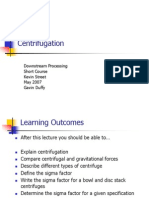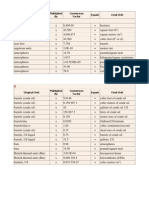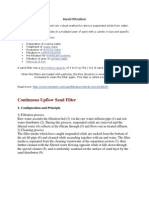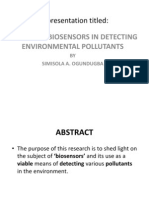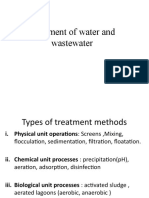Sedimentation: Downstream Processing Short Course May 2007 Kevin Street Gavin Duffy
Uploaded by
Jay CruzatSedimentation: Downstream Processing Short Course May 2007 Kevin Street Gavin Duffy
Uploaded by
Jay CruzatSedimentation
Downstream Processing
Short Course
May 2007
Kevin Street
Gavin Duffy
Bioprocess Overview
Solid-liquid
Separation
Concentration
Purification
Formulation
Intra-Cellular
Product
Final Product
Extra-Cellular
Product
Cell Disruption
Upstream Processing
Centrifugation/Sedimentation,
Extraction, Filtration
Evaporation, Ultrafiltration,
Adsorption, Precipitation
Chromatography
Crystallisation, freeze drying,
Spray drying, sterile filtration
Chemical/Enzymatic/
Mechanical/Physical
Basic Biotechnology, 2
nd
Ed, Ch 9
Learning Outcomes
After this lecture you should be able to
Describe the sedimentation process and equipment
Describe the motion of particles in free fall
Calculate the terminal velocity of a particle
Sedimentation
This is the separation of a liquid from particles
suspended in the liquid
A particle, falling from rest, accelerates under the force
of gravity
The drag force increases so the acceleration decreases
(liquid viscosity is important here)
Acceleration eventually becomes zero the terminal
velocity is reached
Terminal velocity is reached quickly, e.g. a 100 m
particle in water reaches 2 mm/s in 1.5 ms
Upward velocity of liquid must be less than terminal
velocity for sedimentation to work
We must know the terminal velocity!
Sedimentation Tank
Single Particle Terminal velocity
For low Particle Reynolds number:
Creeping flow
Drag coefficient increases with velocity
Stokes law region
For high Particle Reynolds number:
Inertial flow (fluid must accelerate out of path)
Drag coefficient constant
( )
18
2
g d
u
f p
T
=
( )
2 1
74 . 1
|
|
.
|
\
|
=
f
f p
T
g d
u
Drag coefficient
The drag coefficient is defined as:
R is the drag force per unit projected area (N)
u is the velocity (m/s)
f
is the fluid density (kg/m
3
)
(What are the units of C
D
?)
Stokes law region:
Intermediate region:
Newtons law region:
2
2
u
R
C
f
D
'
=
p
D
C
Re
24
=
44 . 0
Re
24
+ =
p
D
C
44 . 0 =
D
C
Drag curve for motion of a particle in fluid
Introduction to Particle Technology, Martin Rhodes, Ch 1
Stokes
Newtons
BL separation
Sphericity
Sphericity = surface area of equivalent sphere
surface area of particle
Equivalent sphere = sphere of same volume as particle
Deviation from sphere does not matter in Stokes law
region as much as in Newtons law region
Particles fall with their small surface pointed
downwards in Stokes law region
The largest surface is pointed downwards in
Newtons law region
Activity Calculate Terminal Velocity
What are the particle Reynolds number and terminal
velocity for the following system?
Diameter 3 m
Density of solid phase 1090 kg/m
3
Cell free liquid density 1025 kg/m
3
Cell free liquid viscosity 0.005 Pa.s
Data taken from a case study of r-HSA production with recombinant Pichia Pastoris prepared by L Van der Wielen, European Federation on
Biotechnology
If you dont know which region
Calculate C
D
Re
2
from the following eqn:
Use result to draw a line on the drag curve
For example, suppose C
D
Re
2
= 8
Then, for Re = 10 Re
2
= 100 C
D
= 0.08
for Re = 1 Re
2
= 1 C
D
= 8
for Re = 0.1 Re
2
= 0.01 C
D
= 800
Use these points to draw the line and read the Particle
Reynolds number. The velocity is then obtained
( )
2
3
2
3
4
Re
g d
C
f p f
p D
=
..use the Re v Drag coefficient chart
x
x
x
The Thickener
Feed added gently just below surface
Upward velocity of liquid must be less than u
T
Capacity depends on area: big area = low velocity (Q = va)
Degree of thickening depends on residence time which depends
on height
Can heat tank to reduce viscosity and increase u
T
Limit to solids flux
http://www.filtration-and-separation.com/thickener/sld004.htm 20/4/07
Batch Settling Test
Thickener Area Calculation
where A = area (m
2
)
Q
0
= feed rate of suspension (m
3
/s)
Y = mass ratio liquid to solid in feed
U = mass ratio liquid to solid in underflow
C = particle volume fraction (1-)
s
= density of solid (kg/m
3
)
u
T
= terminal velocity at conc. C (m/s)
f
= density of liquid (kg/m
3
)
( )
f T
s
u
C U Y Q
A
=
0
Activity Calculate Terminal Velocity
based on worked example 2.1 from Rhodes.
You might also like
- Water Treatment: Monroe L. Weber-Shirk S Civil Environmental EngineeringNo ratings yetWater Treatment: Monroe L. Weber-Shirk S Civil Environmental Engineering80 pages
- Principles of Toxicology: The Study of PoisonsNo ratings yetPrinciples of Toxicology: The Study of Poisons42 pages
- Original Unit Multiplied by Conversion Factor Equals Final UnitNo ratings yetOriginal Unit Multiplied by Conversion Factor Equals Final Unit12 pages
- Total Quality Management Unit-I: DefinitionNo ratings yetTotal Quality Management Unit-I: Definition86 pages
- Paints Characterization Techniques With ASTM StandardsNo ratings yetPaints Characterization Techniques With ASTM Standards55 pages
- Organisation of Pharmaceutical Producers of India: Issue 12, June 2009No ratings yetOrganisation of Pharmaceutical Producers of India: Issue 12, June 200931 pages
- EMS/ISO 14000 Need of The Hour: National Environmental Engineering Research InstituteNo ratings yetEMS/ISO 14000 Need of The Hour: National Environmental Engineering Research Institute38 pages
- Advanced Wastewater Treatment: Gyeongsang National UniversityNo ratings yetAdvanced Wastewater Treatment: Gyeongsang National University31 pages
- 9.6.2023 - Shorthand Notes On Sewage Sludge Treatment and DisposalNo ratings yet9.6.2023 - Shorthand Notes On Sewage Sludge Treatment and Disposal17 pages
- Activated Sludge Process and Filtration (Wastewater)No ratings yetActivated Sludge Process and Filtration (Wastewater)7 pages
- Anaerobic Baffled Reactor (ABR) - SSWM PDFNo ratings yetAnaerobic Baffled Reactor (ABR) - SSWM PDF9 pages
- LECTURE 11 - Conventional Water Treatment Facility2014No ratings yetLECTURE 11 - Conventional Water Treatment Facility201451 pages
- Superfluidity: Superfluidity Is The Characteristic Property of A Fluid With ZeroNo ratings yetSuperfluidity: Superfluidity Is The Characteristic Property of A Fluid With Zero4 pages
- UV Disinfection Radiation and Wastewater Quality Parameters As Operational IndicatorsNo ratings yetUV Disinfection Radiation and Wastewater Quality Parameters As Operational Indicators6 pages
- Lecture Iii Cve 503 Biological Treatment of Wastewater1100% (2)Lecture Iii Cve 503 Biological Treatment of Wastewater141 pages
- Aircraft Fatigue Loading: Landing and Ground LoadsNo ratings yetAircraft Fatigue Loading: Landing and Ground Loads17 pages
- Oxidation of Acetaminophen by Fluidized-Bed Fenton Process: Optimization Using Box-Behnken DesignNo ratings yetOxidation of Acetaminophen by Fluidized-Bed Fenton Process: Optimization Using Box-Behnken Design12 pages
- Potable Water Purification: Water Treatment Describes Those Industrial-Scale Processes Used To MakeNo ratings yetPotable Water Purification: Water Treatment Describes Those Industrial-Scale Processes Used To Make7 pages
- Sedimentation: Downstream Processing Short Course May 2007 Kevin Street Gavin DuffyNo ratings yetSedimentation: Downstream Processing Short Course May 2007 Kevin Street Gavin Duffy16 pages
- Tomas Ang v. Associated Bank, GR No. 146511, 2007-09-05No ratings yetTomas Ang v. Associated Bank, GR No. 146511, 2007-09-055 pages
- POLIAND INDUSTRIAL LIMITED vs. NATIONAL DEVELOPMENT COMPANY, DEVELOPMENT BANK OF THE PHILIPPINES100% (1)POLIAND INDUSTRIAL LIMITED vs. NATIONAL DEVELOPMENT COMPANY, DEVELOPMENT BANK OF THE PHILIPPINES6 pages
- Ayala Corporation VS. ROSA DIANA REALTY Case Digest: By: Jayrick V. CruzatNo ratings yetAyala Corporation VS. ROSA DIANA REALTY Case Digest: By: Jayrick V. Cruzat8 pages
- Sphericity: W.R. Wilcox, Clarkson University, May 18, 2009No ratings yetSphericity: W.R. Wilcox, Clarkson University, May 18, 20091 page
- Water Treatment: Monroe L. Weber-Shirk S Civil Environmental EngineeringWater Treatment: Monroe L. Weber-Shirk S Civil Environmental Engineering
- Original Unit Multiplied by Conversion Factor Equals Final UnitOriginal Unit Multiplied by Conversion Factor Equals Final Unit
- Paints Characterization Techniques With ASTM StandardsPaints Characterization Techniques With ASTM Standards
- Organisation of Pharmaceutical Producers of India: Issue 12, June 2009Organisation of Pharmaceutical Producers of India: Issue 12, June 2009
- EMS/ISO 14000 Need of The Hour: National Environmental Engineering Research InstituteEMS/ISO 14000 Need of The Hour: National Environmental Engineering Research Institute
- Advanced Wastewater Treatment: Gyeongsang National UniversityAdvanced Wastewater Treatment: Gyeongsang National University
- 9.6.2023 - Shorthand Notes On Sewage Sludge Treatment and Disposal9.6.2023 - Shorthand Notes On Sewage Sludge Treatment and Disposal
- Activated Sludge Process and Filtration (Wastewater)Activated Sludge Process and Filtration (Wastewater)
- LECTURE 11 - Conventional Water Treatment Facility2014LECTURE 11 - Conventional Water Treatment Facility2014
- Superfluidity: Superfluidity Is The Characteristic Property of A Fluid With ZeroSuperfluidity: Superfluidity Is The Characteristic Property of A Fluid With Zero
- UV Disinfection Radiation and Wastewater Quality Parameters As Operational IndicatorsUV Disinfection Radiation and Wastewater Quality Parameters As Operational Indicators
- Lecture Iii Cve 503 Biological Treatment of Wastewater1Lecture Iii Cve 503 Biological Treatment of Wastewater1
- Aircraft Fatigue Loading: Landing and Ground LoadsAircraft Fatigue Loading: Landing and Ground Loads
- Oxidation of Acetaminophen by Fluidized-Bed Fenton Process: Optimization Using Box-Behnken DesignOxidation of Acetaminophen by Fluidized-Bed Fenton Process: Optimization Using Box-Behnken Design
- Potable Water Purification: Water Treatment Describes Those Industrial-Scale Processes Used To MakePotable Water Purification: Water Treatment Describes Those Industrial-Scale Processes Used To Make
- Sedimentation: Downstream Processing Short Course May 2007 Kevin Street Gavin DuffySedimentation: Downstream Processing Short Course May 2007 Kevin Street Gavin Duffy
- Tomas Ang v. Associated Bank, GR No. 146511, 2007-09-05Tomas Ang v. Associated Bank, GR No. 146511, 2007-09-05
- POLIAND INDUSTRIAL LIMITED vs. NATIONAL DEVELOPMENT COMPANY, DEVELOPMENT BANK OF THE PHILIPPINESPOLIAND INDUSTRIAL LIMITED vs. NATIONAL DEVELOPMENT COMPANY, DEVELOPMENT BANK OF THE PHILIPPINES
- Ayala Corporation VS. ROSA DIANA REALTY Case Digest: By: Jayrick V. CruzatAyala Corporation VS. ROSA DIANA REALTY Case Digest: By: Jayrick V. Cruzat
- Sphericity: W.R. Wilcox, Clarkson University, May 18, 2009Sphericity: W.R. Wilcox, Clarkson University, May 18, 2009


